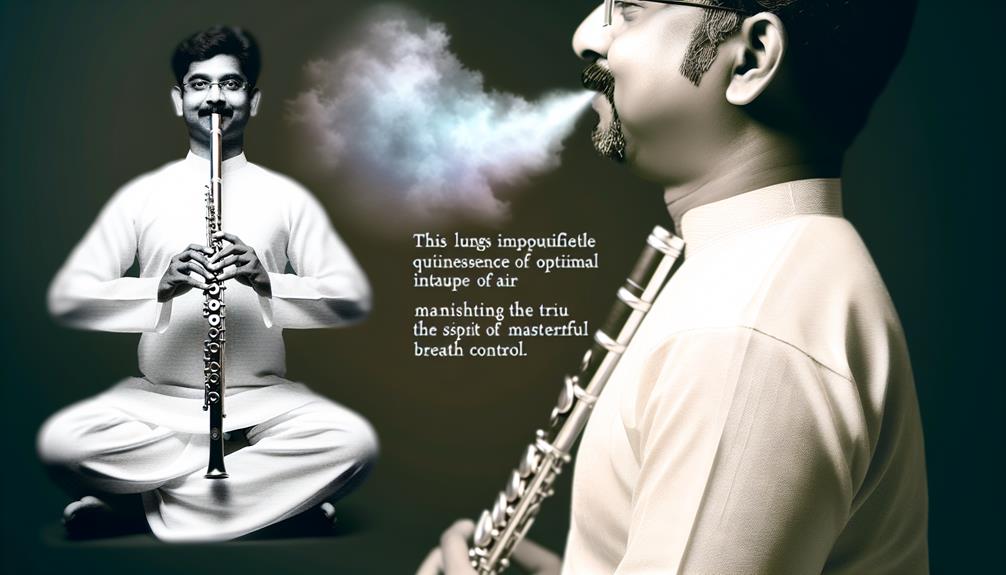Breath control stands as a fundamental aspect of a flutist's mastery, shaping the very essence of their musical expression. With a focus on precision and technique, mastering breath control opens doors to a world of nuanced interpretation and emotive storytelling through music. By delving into the intricacies of breath management, flutists unlock the key to captivating performances that resonate deeply with audiences. The journey to harnessing this essential skill is a fascinating exploration that unveils the true artistry and finesse behind the delicate balance of breath and melody.
Key Takeaways
- Practice diaphragmatic breathing for enhanced resonance and breath capacity.
- Engage in lung capacity exercises to improve endurance and breath control.
- Coordinate articulation with controlled airflow for clarity and emotional connection.
- Utilize breath support for dynamic range, phrasing, and musical expression.
- Manage nervousness with relaxation techniques for confident and steady breath control.
Importance of Breath Control
Breath control is the cornerstone of a flutist's technique, essential for producing clear, sustained tones and executing intricate passages with precision and grace. Mastering breath control offers numerous benefits to flutists beyond just playing the instrument. It enhances mindfulness, requiring a deep connection between the body, mind, and music. By focusing on the breath, flutists can enter a state of flow where the music effortlessly flows through them.
Improving breath control also directly impacts a flutist's endurance. Through proper breathing techniques, flutists can sustain long phrases without compromising the quality of their sound. This endurance is crucial during performances, rehearsals, or lengthy practice sessions. By incorporating mindful breathing exercises into their daily routine, flutists can strengthen their respiratory muscles and increase their lung capacity, leading to improved stamina and overall performance quality.
Furthermore, breath control plays a pivotal role in phrasing and dynamics. Flutists who have mastered their breath can artfully shape phrases, infuse expression into their playing, and seamlessly navigate dynamic contrasts. This level of control not only enhances the musicality of their performance but also captivates audiences and creates a profound emotional connection through music. In essence, developing superior breath control transcends technical proficiency; it elevates a flutist's artistry to new heights.
Diaphragmatic Breathing Technique
Utilizing the diaphragmatic breathing technique is a fundamental aspect of developing optimal breath control for flutists. This technique involves engaging the diaphragm, a dome-shaped muscle located at the base of the lungs, to control the inhalation and exhalation of air. By mastering diaphragmatic breathing, flutists can enhance their tone quality, increase their breath capacity, and sustain longer phrases with greater control and stability.
Key Points to Consider:
- Improved Resonance: Diaphragmatic breathing allows flutists to support their sound more effectively, resulting in a richer and more resonant tone quality.
- Enhanced Endurance: By utilizing the diaphragm to its full potential, flutists can increase their breath capacity, enabling them to play for longer periods without fatigue.
- Greater Dynamic Range: This breathing technique provides flutists with the ability to control the airflow more precisely, facilitating a wider dynamic range in their playing.
- Increased Relaxation: Engaging the diaphragm promotes a sense of relaxation and reduces tension in the body, leading to a more effortless and enjoyable playing experience.
Incorporating diaphragmatic breathing techniques into daily practice routines can significantly benefit flutists, allowing them to unlock their full potential and achieve mastery in breath control. By focusing on this foundational aspect of breathing, flutists can lay a solid groundwork for further developing their skills and musical expression.
Exercises for Lung Capacity
Developing lung capacity is crucial for flutists aiming to optimize their breath control and overall performance quality. By incorporating specific breathing exercises into their practice routine, flutists can enhance their lung health and strengthen their respiratory muscles, leading to improved endurance and sustained breath control while playing.
One effective exercise for increasing lung capacity involves deep breathing techniques. Flutists can practice inhaling deeply through their nose, expanding their diaphragm and filling their lungs to their maximum capacity, then exhaling slowly and completely. This exercise not only expands lung capacity but also encourages proper breathing mechanics essential for playing the flute.
Another beneficial exercise is pursed lip breathing, where flutists inhale slowly through their nose for a count of two, then exhale through pursed lips as if blowing out a candle for a count of four. This exercise helps improve the exchange of oxygen and carbon dioxide in the lungs, enhancing overall lung function.
Consistent practice of these breathing exercises not only boosts lung capacity but also promotes better breath control and efficiency while playing the flute. By prioritizing lung health and incorporating these exercises into their daily warm-up routine, flutists can elevate their performance quality and achieve greater musical expression.
Articulation and Breath Coordination
To achieve seamless and expressive musical performances, flutists must master the intricate balance between articulation and breath coordination. Articulation refers to the way in which notes are started and ended, greatly influencing the overall musical phrasing and emotion conveyed to the audience. It is a crucial element that, when combined with precise breath control, can elevate a performance to new heights.
When focusing on articulation and breath coordination, flutists should pay close attention to:
- Tongue placement: The position of the tongue inside the mouth can significantly affect the clarity and precision of each note. Proper tongue placement helps in articulating notes cleanly and accurately, contributing to the overall musical expression.
- Airflow direction: Controlling the direction and speed of airflow is essential for maintaining a consistent tone quality and achieving smooth transitions between notes. Flutists must learn to coordinate their breath with the movement of their tongue to produce a seamless and connected sound.
- Emotional connection: By mastering articulation and breath coordination, flutists can establish a deep emotional connection with the music they are playing, captivating their audience and creating a truly immersive musical experience.
- Expressive phrasing: The ability to effectively articulate notes while maintaining a steady airflow allows flutists to craft dynamic and expressive phrasing, adding color and depth to their performances.
Utilizing Breath Support for Dynamics
Effective breath support is a foundational element in achieving dynamic range and control in flute playing, enhancing the performer's ability to convey musical nuances with precision and artistry. Dynamic phrasing, a crucial aspect of musical expression, is heavily reliant on the flutist's breath control techniques. To master dynamic phrasing, flutists must understand how to utilize breath support effectively to modulate the volume and intensity of their playing.
When aiming for a crescendo, where the music gradually increases in volume, flutists need to engage their diaphragm and abdominal muscles to sustain a steady stream of air. This controlled release of air allows for a seamless transition from soft to loud passages, creating a sense of tension and release in the music. Conversely, when executing a diminuendo, the gradual decrease in volume, flutists must maintain consistent breath support while gently reducing the airflow to produce a smooth and controlled decrease in sound intensity.
Mastering Breath Control in Performance
Achieving mastery in breath control is essential for flutists seeking to elevate their performance to a higher level of precision and musicality. In the realm of performance, breath control becomes not just a technical skill but a means of artistic expression and emotional connection with the audience. To truly excel in this aspect, flutists must harness their breath efficiency and stamina while effectively managing both performance nerves and breath intake.
- Performance Stamina: Building endurance is crucial for sustaining long phrases and demanding pieces without compromising tone quality or musicality. It allows flutists to deliver consistent performances from start to finish, captivating listeners throughout the musical journey.
- Breath Efficiency: Maximizing the use of each breath is key to maintaining a smooth and uninterrupted sound. Efficient breathing techniques help flutists navigate challenging passages with ease, enabling them to convey their musical intentions with clarity and finesse.
- Nervousness Management: Controlling performance anxiety is vital for ensuring steady breath control. By implementing relaxation techniques and mental strategies, flutists can mitigate the effects of nerves and deliver confident, expressive performances.
- Breath Management: Understanding when and how to take breaths in a piece is essential for maintaining the flow of music. Strategic breath planning allows flutists to emphasize phrasing, highlight musical nuances, and engage listeners through compelling interpretations.
Frequently Asked Questions
How Can I Maintain Breath Control During Fast-Paced Musical Passages?
Maintaining breath control during fast-paced musical passages requires a combination of breathing exercises and mindfulness techniques. Proper posture and relaxation techniques are also essential in achieving this goal.
What Are Common Mistakes Flutists Make That Hinder Breath Control?
Common mistakes flutists make that hinder breath control often stem from improper posture and inadequate use of diaphragmatic breathing techniques. Slouching or tensing up can restrict airflow, affecting performance quality.
Diaphragmatic breathing, essential for sustained notes and control, is frequently neglected. Understanding the importance of proper posture and mastering diaphragmatic breathing can significantly enhance a flutist's breath control, leading to improved musical expression and performance outcomes.
Can Anxiety Affect Breath Control and How Can It Be Managed?
Anxiety can indeed impact breath control, affecting performers in various fields. Managing anxiety requires a multifaceted approach, including relaxation techniques such as deep breathing exercises and progressive muscle relaxation.
Mental focus plays a crucial role; mindfulness practices, visualization, and positive affirmations can help calm nerves and improve breath control. Engaging in regular mindfulness exercises can promote a sense of calm and enhance overall performance.
Are There Specific Foods or Drinks That Can Improve Breath Control?
Hydration and snacks play a vital role in improving breath control. Foods rich in antioxidants like berries can benefit lung function. Additionally, staying well-hydrated ensures optimal respiratory performance.
Incorporating breathing exercises and mindfulness techniques can further enhance breath control. Avoiding caffeine and alcohol, which can dehydrate the body, is advisable.
How Can I Prevent Dizziness or Lightheadedness While Playing Due to Breath Control?
To prevent dizziness or lightheadedness while playing due to breath control, focus on breathing exercises to improve lung capacity and control.
Incorporate relaxation techniques to ease tension.
Stay hydrated and maintain proper posture awareness.
Conclusion
In the delicate dance of music, breath control serves as the silent conductor, guiding the flutist through each note with grace and precision.
Like a gentle breeze shaping the melody, mastering breath control unlocks a world of expressive possibilities, allowing the music to soar and resonate deeply within the soul of the listener.
With each breath, a story is told, emotions are shared, and connections are made, creating a symphony of beauty that transcends words.

